Update: Due to Panama's coronavirus quarantine, Easter 2020 will be much different than usual. However, the food eaten will be pretty much unchanged. I hope you and your family are healthy and safe this holiday.
During Lent, Catholics are not supposed to eat meat on Fridays. They are allowed to eat fish.
(FYI, Lent is the approximately 40 day period leading up to Easter.)
So, as you can imagine, fish consumption, particularly of the popular Corvina and Pargo (red snapper) increase dramatically.
Click to find out more about Easter in Panama
The following are 3 popular ways to prepare fish in Panama during Semana Santa and all year long.
Bacalao
There is one fish, in particular, which is traditionally eaten during Semana Santa. That is Bacalao, a dried and salted codfish. Bacalao is popular in many Latin American countries.
Bacalao is served with either rice or potatoes and, as I said, is a popular dish for Easter. The Panamanian newspaper La Estrella has a recipe for "Bacalao for Semana Santa" (in Spanish), here.
Important: If you do decide to make a Bacalao dish, remember you must soak it in cold water for about 24 hours, changing the water at least 3 times during that time. You must do this to remove all the excess salt BEFORE cooking it, otherwise, it will be inedible.
Pan Bon is a dark sweet bread that is very popular around Semana Santa.
These round loaves are made with dried fruit, local cheese, and orange rinds. During Semana Santa, a dollop of lighter dough in the shape of a crown or cross is often applied to the top of the loaf.
According to what I have read, Pan Bon is said to represent the bread that Jesus broke at the Last Supper.
I purchased a loaf of Pan Bon, see photo, directly from a person selling them on the street in Puerto Armuelles. My family did not love it, probably because had been over-baked and was dry.
It takes hours to make Pan Bon, because the dough is worked and left to rise several times. Here are 2 links with recipes for it at BlueJellyBeans.com and Quericavida.com
For Easter, chicheme is popular. Chicheme is a drink with milk, corn, and rice seasoned with cinnamon. Many people find that it tastes pretty good, if a bit chunky.
Not everyone likes it though. My daughter Blaise thinks it feels too pasty in your mouth because of all the starch in the drink.
Different regions of Panama have their own traditional food to eat during Semana Santa.
Breakfasts during Lent and Holy Week in the Herrera province typically consist of polenta-like bollo, a simple farmer’s cheese, and dried or smoked bacalao.
On Good Friday in the Colon province, bacalao is served in escabeche, a vinegary concoction made with veggies and hot peppers.
On the Caribbean Coast, enyucado is served. Enyucado is a cross between a pudding and a casserole. The dish consists of sweetened grated yucca, fragrant anise seeds, shredded coconut, and crumbles of white farmer’s cheese.
On Good Friday in many parts of rural Panama, unshelled cashews are traditionally roasted over an open fire and eaten. It is a long and laborious process, and care must be taken that the husks don't burn.
During Holy week in the Chiriqui province and other regions, a sweet called cocada is popular. Cocada is made of cashews. The cashews are pried from the “apples” on which they grow around this time of year.
The cashews are roasted and shelled—usually by hand—then added to a sweet, gooey mixture of coconut and sugar cane syrup spiced with cinnamon. After the mixture cools, it is formed into little molasses-colored balls.
In the Cocle province, an even more unusual, but similar preparation is made during holy week. It is called dulce de frijoles. It is made the same way as cocada, but instead of cashews, cooked beans are the main ingredient.
You can learn more about Easter celebrations, information, and tips, by reading my Panama Easter article.
If you have kids in Panama, you may be interested in how I have tried to keep our Easter bunny tradition alive for our expat kids.
An invaluable source I used for this article was written by the Toscana Inn Hotel, especially in regards to foods favored by different regions of Panama.
My daughters explain how to preserve your bananas and more in the video above.
Betsy: Welcome to the 2nd video in our "Fruit in Our Yard" series.
By the way, our yard is in the charming beach town of Puerto Armuelles, Panama.
We are producing these videos in alphabetic order.
Join us as my daughters show you the Bananas In Our Yard.
[I'm Betsy from Living in Panama, the place for information and advice on being an expat in Panama. Interested? Click subscribe, and hit the bell. So you don't miss a video.]
Skylar: These are the bananas in our yard. They're a little past their prime on the tree.
We've been picking them slowly.
Normally, if you wanted to preserve the entire bunch and ripen them at your leisure, you would chop it here and hang it from a sort of a rafter or any high place you have. Then put a bag around it to protect it from the birds that might want to get at it before you.
Blaise: And what you can also do is, you can leave actually them on the tree and get some mesh bags to cover it.
And as you can see, some ripen at different times.
These are very small, just starting. These are green and these towards the top get more sun and are ripe. Like here, they are ready on this side.
Skylar: Yes. These here have been all picked and some of them have been eaten by birds.
Blaise: Like these and that.
Skylar: This is what happens when you don't preserve the bunch. So if you wanted to preserve it, as we said, you put a mesh bag around, either on the tree, or take it off and hang it somewhere for it to ripen.
[Note: you can use plastic or any other opaque bag to cover ripening bananas in order to keep birds from eating them.]
They usually ripen better off the tree actually.
Blaise: And we can show you one is still green. It has not been covered, over in our front yard.
Skylar: Okay, so this is across the yard from the earlier bananas that we showed you. But these are not quite ready to be picked or even for the birds to want them.
It's quite a beautiful bunch, honestly.
Blaise: As you can see, up there, it is starting to ripen a little bit on the higher branches.
Betsy: Where? Oh, yeah.
Blaise: You can see a little yellow. And so that is normally the time you should probably start bagging.
Actually, if you remove some of the leaves above it, it can help it as well.
Betsy: Help it what?
Skylar: Ripen more quickly of course.
Blaise: And grow.
Skylar: Yeah.
Blaise: And in the next video we'll probably be showing you how to use bananas and plantains in dishes.
Skylar: Yes, how to cook your bananas or plantains - for beginners.
Skylar & Blaise: Bye. Thank you for watching. Subscribe. And like. And share with anyone who might be interested. And click the notification bell. Have fun.
Betsy: Please click the link below for more information about Puerto Armuelles. Thanks for watching.
Our next "Fruit In Our Yard" video will feature the cashew tree.
So instead of one long video, we are making 13 short ones.
We are producing the videos in them in alphabetical order, as follows.
(1) Almonds, 2) Bananas, 3) Cashews, 4) Coconuts, 5) Crioyos (native orange) 6) Eucalyptus (rainbow type - yes, not a fruit, but its leaves are useful), 7) Lemons, 8) Mangos, 9) Maracuya (Passion Fruit), 10) Nance, 11) Papaya, 12) Pineapple, and 13) Plantains. There are many more fruits in Panama, but these are the ones that grow in our yard, or right across the street.
In this 1st video, we celebrate the tropical almond.
Transcription of the video appears further down the page.
True Almond trees do not grow in the tropics. Panama's almond tree (Terminalia catappa) is not related to the true almond tree. True almond trees are the ones that produce the almonds we buy at the store.
The tropical almond tree got its name because its seed pods look like large unshelled almonds plus its seeds/kernels resemble almonds. It also goes by many other names: sea-almond, Indian-almond, false-almond, country-almond, and many more.
However, unlike true almonds, the outside of the fruit is also edible. Plus you don't have to cook the seed to eat it. Both the seeds and the fruit of the tropical almond are edible in the uncooked, raw state,
The tropical almond tree grows by the ocean. The tree can grow in sandy soil and is mildly salt tolerant.
This large, fast-growing tree can reach, on average, 30-55 feet tall. It has large bright green leaves that turn red before falling off. The tree also produces many small, white flowers which develop into fruits. The flower's scent is barely noticeable.
The tree will produce fruit and nuts within 3-5 years. Seasonally, you can harvest up to 11 pounds of nuts (shelled) from a tree.
It is a messy tree. Leaves, fruit, and kernels litter the ground underneath it. This can be a problem because the fruit contains high amounts of tannic acid so it will stain any paving, maybe even your car, if they are under the tree too.
Interestingly, the tree does not attract much wildlife. Some tropical ants like it. Fruit bats eat the husk. And bees are attracted to the blossom, but apparently, have a difficult time making honey from them.
It's all edible. (If you know the movie Rocky Balboa, you may recognize that line.)
The fruit has a pleasant aroma, but is not especially tasty, although it is edible. The fruit ripens from green to yellow to red and has very little pulp, but a very large seed kernel. The husk is corky, thin with green flesh inside.
The ripe husks of the fruit can be eaten raw and are best when young and sweet. Although when the fruit is ripe can vary.
The seeds have an almond or hazelnut flavor.
The waterproof nature of the tree’s wood makes its lumber ideal for canoes.
The leaves and bark are sometimes put in fish tanks to increase water acidity and reduce bacterial infections amongst the tank’s inhabitants.
Medicinally, the tree has had a myriad of uses in folk medicine for everything from sickle cell disorders, leprosy, nausea, diarrhea, and as a contraceptive.
However, there is research that suggests it might be useful in treating high blood pressure. Also, leaf extracts have some anti-diabetic and antioxidant properties.
There is much more fruit in Panama than the 13 we are covering in our "Fruit In Our Yard" video series. But only those 13 fruits grow in our yard.
The following Panama fruit do not grow in our yard (although most of them do grow in our neighborhood): Avocados, Breadfruit, Cacao, Grapefruit, Guanábana, Noni, Mangosteens, Momo chinos, Tamarindo, and more.
Up Next: Bananas. Check out the banana video here.
Betsy: Welcome to the first of our series: Fruit in Our Yard.
We're doing it alphabetically.
We're starting with almonds going through coconuts, lemons, nance, papayas, pineapple, and ending at plantains, and lots and between.
Right today, we're starting with Almonds.
Subscribe Plug: Its Betsy of living in Panama, the place for information and advice on being an expat in Panama. Interested? Click subscribe and hit the bell so you don't miss a video.
Skylar: Okay. So this may be cheating a little. It's a little out of our yard.
Betsy: It's across the street.
Skylar: It's across the street, but I think it's very interesting. This is an almond tree.
Blaise: It looks basically like a cashew tree, actually.
Skylar: I didn't know where almonds grew before I came to Panama. But given that I was five, it wasn't that unimpressive.
But yeah. So actually, here is one right now.
Blaise: They grow in little pods.
Blaise & Skylar: They look like this. This is a very under-ripe one.
The ripe ones are fuller and more spotted. Ripe ones are larger, yellower, more even, and they have some brown speckling. And as can see here, this has none. Maybe this one, this has one speckle, but it would be all over it and all these ridges would fill out.
But inside here. It's a little meaty on the inside. Then you have the seed, which is the almond.
Betsy: You should know that with the tropical Almond, both the seed pod and the seed are edible, without any cooking. Although it's quite the endeavor, especially to get the seed out, as the girls mention
Skylar & Blaise: It's pretty straightforward. Although, it might be a little more effort than it's worth than buying a bag. You should just buy 'em. Buy em.
The modern world is wonderful. Don't need these [raw seed pods] anymore. It's just a great tree though.
As you see...
Betsy: Join us next time as we explore the bananas in our yard.
Skylar & Blaise: Thanks for watching. Be sure to like comment, share, subscribe, and click the bell icon if you want notifications.
Betsy: For more information about tropical almonds and life in Panama. Click the link below. See you there.
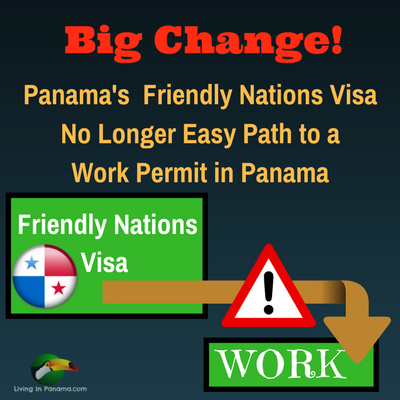
On February 15, 2017, the Ministry of Labor issued a new work permit requirement for foreigners with either a Friendly Nations or Professional Foreigner visa.
To apply for a work permit, those visa holders must now have an approved and stamped employment contract with a Panamanian company and be enrolled in the local payroll system.
This is a big change. Before you did not have to have a job in order to get a work permit, at least not for holders of a Friendly Nation visa.
This is a big set back for people who simply wanted to work in their own business. For instance, a foreigner can open a restaurant in Panama. But if you also want to wait tables at your restaurant, you need a work permit. (Please consult a good lawyer to get a full picture on how this new regulation may impact you.)
Of course, there are other ways to get a work permit.
The Friendly Nations visa was originally created in 2012 to attract more skilled workers to Panama. There simply were not enough skilled Panamanian workers to meet the need of local companies. To remedy this, government created the Friendly Nations visa and explicitly linked it to an expedited work permit process.
But the recent uproar over rising number of illegal workers in Panama has put a halt to that. Recent and significant changes to Panama Tourist visas have also been made to help stop the influx of foreigners working here illegally.
The Friendly Nations Visa itself doesn't give you the right to work, so it may not get caught up in this drive to curtail foreign workers. However, given the public sentiment, it may go away. If you were thinking of applying for one, it is better to apply sooner rather than later - or too late.
The official government site explains what you need for a work permit with the Friendly Nations Visa. However, what that site says or the exact wording of the law may not determine how your work permit application is treated. There is an interpretation that the law, and that interpretation is still in flux. But for now it seems that unless you had your work permit application in before March, you won't be getting one. That is, unless you have a job offer from a qualifying Panamanian company.
Find out more about the Friendly Nations Visa here
The good news is that Friendly Nations and Professional Foreigner visa holders will still not be considered in calculating a company’s foreign-to-local worker ratio. This is still true even though these visa holders must now have a local employment contract and be paid through a local payroll.
This means that those visa holders will still have an edge on getting a job with a local company since they won't impact the company's ratio numbers.
(FYI, Panamanian laws establish that only 10% of a company’s work force can be foreign (non-Panamanian); exceptions include if a worker is married to a Panamanian, or if the worker has lived in Panama for 10 or more years).
This easy link between the Friendly Nations visa and a work permit is an innocent victim of public outrage.
Panama has experienced an alarming rise in foreigners, on a tourist visa, who are working in Panama. It is illegal to work in Panama if you are on a tourist visa. Until very recently, these foreigners, mostly from other Latin American countries, only needed to hop over the border to renew their tourist visa. And then go back to their jobs.
Panama has now made changes to tourist visa regulations to eliminate this easy visa renewal border hop. It was a good move.
However, this work permit change seems like a knee jerk reaction to the public outrage over the illegal workers. Making it harder for holders of these 2 residency visas to get a work permit does not help eliminate illegal workers. Foreigners who apply for a work permit, obviously want to work legally. By further restricting the ability of foreigners to get a work permit, they only make it more tempting for them to work illegally in Panama.
The easiest way to make money while living in Panama is to earn it outside-of-Panama. You can work online in various capacities, work your job remotely from Panama, and other ways.
In a previous post, I wrote up some ideas on how to make money in Panama .
Check out these beautiful & affordable properties
These properties have some of the lowest per meter prices you will find in Puerto Armuelles – or in Panama.
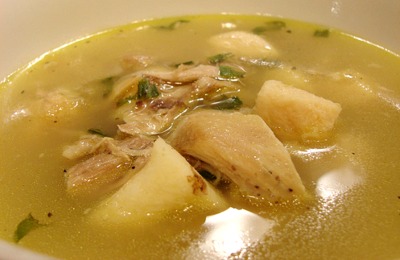
Many claim the soup is even the perfect tonic for a hangover.
A local Panama chef believes that culantro is the secret weapon for a good sancocho.
“Culantro is the flavor you’re going to find in sancocho, even more than the chicken." It’s our traditional dish. It’s the flavor of Panama.”
- local chef Francisco Castro.
Cook time: ~1.5 hours
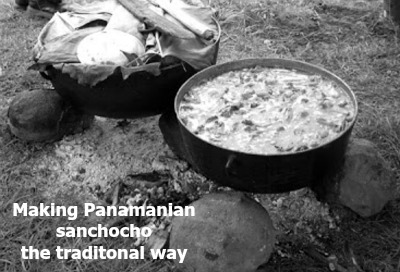
Serving Suggestions
To eat it the Panamanian way, serve it along with white rice on the side. You can either mix the rice into the soup or take a bite with each spoonful. It doesn’t matter, they do both.
Sometimes the soup is accompanied by patacones (fried plantains) as well.
The soup’s ingredients may vary , but almost all of Panama's Sancocho varieties share one characteristic: they are rarely spicy. Typically, Panamanians aren’t fond of spicy foods.
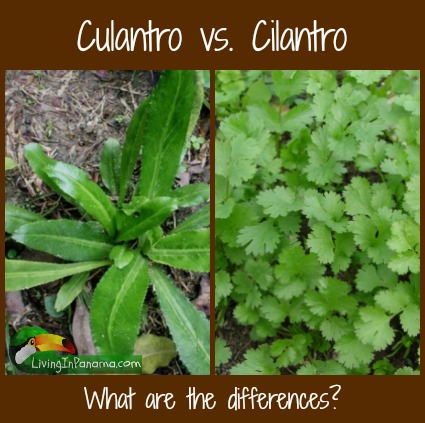
Culantro is used extensively in Panamanian food.
It is easy to find culantro in Panama, cilantro is harder to find.
I can almost always find culantro growing wild in small patches in my yard. It grows in both shade and sun. Sometimes they also sell it in the market and, I've recently been told, you can also sometimes find dried culantro in grocery stores here.
If you are looking for it in the US, Canada, or Europe, you may be able to find it in Asian or Hispanic markets (especially Vietnamese, Thai, Puerto Rican or Dominican Republic markets).
If you want to use cilantro in Panama, your best bet is to grow it yourself. Although, as you will read below, that is not an easy task.
Worldwide, culantro is known by many names: recao, long coriander, ngo-gai, spiritweed, black benny, recao de monte, false coriander, spiny coriander, among others.
Leaves
Cilantro leaves are small and lacy like parsley leaves.
Cilantro leaves grow on stems that are several inches above the ground.
Culantro leaves are long and spiny like dandelion leaves. It's leaves are also much tougher than cilantro leaves. They can grow up to 10 inches long.
Culantro leaves grow in whorls that form at the base of the plant.
Flowers & Propagation
Culantro's flower stalks also have spines. The spines on both the leaves and the stalks become quite sharp as the plant matures. The flower blooms at the top of what looks like a green straw.
This flower will produce seeds. These seed can be used to grow new plants, although, in Panama culantro is self-seeding. It can also be grown from cuttings. Culantro can grow in poor soil with little fertilizer. They are hardy, prefer partial shade, but tolerate full sun.
Cilantro flowers are white and lace-like on a long stem.
Cilantro is not a hardy plant, especially in the tropics. Cilantro is particularly hard to grow in the tropics since it doesn't love heat, but needs to grow in full sun. Cilantro can only be grown here in the cooler months. (For more on Panama climate)
Harvesting
I send my girls out to pick some culantro leaves when I need them. But if you lack children, you can pinch off or cut the leaves at the soil line with scissors.
Leave the newer leaves for use in future meals. Be careful of the spines when gathering the leaves.
Differences in Use
Because culantro has a much stronger flavor, it is usually added during the cooking process. If you want to put it in a salad, cut it into thin ribbons; otherwise use cilantro.
Culantro is a common ingredient in food in Panama. For instance, it is typically one of the main ingredients in a guiso (or sofrito), an aromatic blend of herbs and spices used to flavor many beans, fish, meats, rice and stew dishes.
Guiso. There are a lot of variations of guiso (also know as sofrito throughout latin america). In Panama it is usually called guiso and often consists of a blend of culantro leaves, onion, garlic, fresh tomatoes, and sometimes non-spicy small peppers . Conveniently, you can make it in advance and refrigerate or freeze it for later use.
Cilantro is more likely to be eaten raw in ceviche, salsas or as a garnish.
If you are going to live in Panama, culantro is a herb you will learn to love. Unless, you are like my younger daughter and detest anything that even hints at the taste of cilantro.
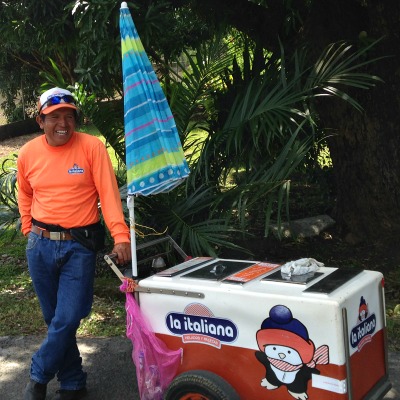
We were all hanging out in hammocks and chairs under the large rancho at our hotel in Pedasi.
They spoke flawless English with the perfect American accent all the Panamanian elites seem to speak with.
We immediately hailed the man pushing the La Italiana ice cream cart. He served ice cream on a stick (paletas in Spanish).
They were right, La Italiana ice cream is excellent. Far superior to any other cart vendor we had tried. Remember, we were traveling with a 5 year old so we had been trying all the ice cream vendors we saw.
In the Chiriqui province, most of the La Italiana ice cream peddlers are Ngobe Bugle indians. I am not sure why, but given the prejudice against Indians here, I imagine it is because it is not a high paying gig.
At the time (about 10 years ago), you could only get La Italiana ice cream from one of these hand carts. You will still see them being pushed down streets all over Panama. But not often enough.
Thankfully, there is at least one La Italiana ice cream store now. It is in David next to El Campion. El Campion is just a few blocks from David's parque central. Luckily, El Campion is very big and recognizable so you can easily spy it. At the La Italiana store you can not only get their usual paletas, but scoops of ice cream as well.
I'm not sure La Italiana is the best ice cream in Panama anymore. Its competition grows steadily.
A month before we had our first paleta from La Italiana, we enjoyed a scoop from what I think was Panama's first gelato ice cream store. It was in the Casco Antiguo neighborhood of Panama City. Now there are gelato stores popping up all over the place: Boquete, Paso Canoas and more.
However, I think that La Italiana is still the best ice cream on a stick in Panama.
Our favorites are the chocolate (think fudgicles) and strawberry paletas.
What are your favorite La Italiana flavors?
Please comment below.
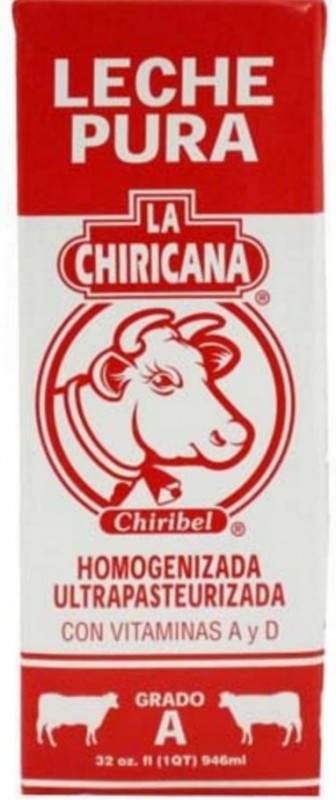
(Scroll down for how milk is made to have a long shelf life.)
You can also easily buy refrigerated milk in Panama. But I found the taste was not consistent. Sometimes it would taste fine, and sometimes it was a little off. Not off as in going bad, just different.
I have learned to love the boxed milk. Now I prefer it. I really don't like running out of milk for my coffee. In the States, I keep a few cans of evaporated milk as a back up. In Panama, a case of boxed milk.
Boxed milk means I don't have to run to the store nearly as often.
The Chiriqui Province, where we live, annually produces over half of the Grade A & B milk in Panama. The Azuero region produces the rest, focusing more on Grade C milk.
Panama’s milk brands include Bonlac, Estrella Azul, Nevada and La Chiricana.
Dos Pinos is also sold in Panama, but it is a Costa Rican brand. Although I hear that Dos Pinos bought both the Nevada and La Chiricana milk companies.
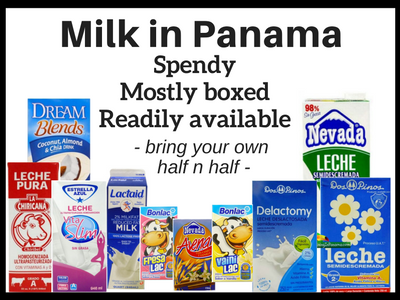
La Chiricana
Locals have come up to me in Romeros (supermarket) to let me know the best milk to buy is La Chiricana.
It is the most popular milk in Panama.
I do like the milk. It is what we usually buy. I haven't tried it's newer low-fat milk which is called, Fit.
Dripping Issue
The issue I have with La Chiricana is that it is impossible to pour milk from the carton without dripping. Frustrating. Which means I not only have to clean up the drips off the counter, but the carton always leaves a tiny milk puddle on my refrigerator shelf.
Life's little trials.
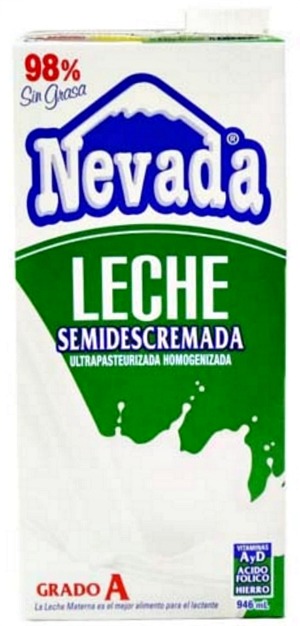
Nevada
If dripping cartons are unacceptable, try our 2nd favorite milk, Nevada. Nevada comes with a pour spout. No more drips!
We used to regularly buy Nevada milk, pictured, when we drank low-fat milk. That was before La Chiricana came out with its low-fat option (Fit).
Nevada offers whole, low-fat, non-fat, and lactose-free milk options. They even have a 2 milks with oatmeal (avena) added (in graphic above)
Bonlac
I have tried Bonlac and I don't like it. I did not like the taste.
Bonlac also offers flavored milks in small child-sized boxes. Very sweet milk. It's strawberry (fresa) and vanilla flavored milks are in the graphic above.
Estrella Azul
This is the milk to buy if you are buying refrigerated milk. I think it tastes the best.
However, we have found that the taste of refrigerated milk can vary, and not usually for the better. It doesn't taste like it is going off, just strange. It is the main reason I gave up on refrigerated milk and started buying boxed milk.
You can get some specialty milk in Panama, such as
In some parts of Panama, you can go to the dairy and buy raw milk.
In the past I have bought milk from right from a farmer, still warm from the cow's udder. I don't do that anymore. The kids were not crazy about the taste, which also was inconsistent. Also I felt compelled to pasteurize it myself on the stove. This was a pain in the neck.
When I was growing up we had raw milk delivered to our house. But it was raw certified milk, meaning it had been tested to make sure it was safe.
I found it interesting that the milk I bought from the farm had very little cream. Much less than I had experienced when drinking raw milk in the States. I am not sure if the farmer skimmed it off before giving it to me, or if it came from a low-fat producing breed of cow, or..
In our area, Finca Santa Marta offers organic goat's milk for sale, as well as a wide range of organic produce, chickens, and more. You can even order online at this link.
Dos Pinos does sell a bag of heavy milk that I have successfully used to replace heavy cream in recipes. Particularly a hot fudge sauce recipe my family loves. I wouldn't use this heavy cream in my coffee though. It has a unique after taste. Unfortunately, at least in my town, this heavy cream is not always available.
Caution: Dos Pinos also sells sour cream in an identical looking bag. The bag is small, cream colored and about 5 x 2 inches. Sorry, I don't have a photo of it.
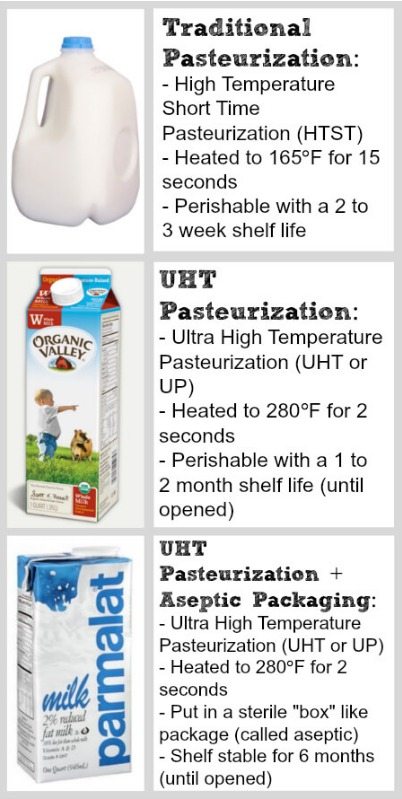
Researching what they do to make milk able to sit on the shelf for 6 months was eye-opening.
But not in the way you think.
I didn't know I had been drinking the milk, even in the States, without realizing it.
Most refrigerated milk, esp. Organic, sold in the States goes through the same Ultra High Temperature (UHT) Pasteurization as non-refrigerated milk.
See the chart for details.
The only difference between UHT pasteurized milk that is refrigerated vs. non-refrigerated is the container. The non-refrigerated milk goes into a sterile box which is made of layers of various materials.
They refrigerated UHT milk in the States because Americans distrusted the warm boxed milk. So they gave us the same milk that is in the boxes, but sold it in the refrigerated section and in familiar-looking cartons. But they didn't tell us. I had no idea.
Popular in Europe & South America
Non-refrigerated milk is very common in Europe and throughout Mexico and South America. I do not know if it is common in Canada or not.
I'd be interested in hearing from someone who does know. Have Canadians embraced boxed milk? (I have heard you can buy milk in bags in Canada. Is that so?). Please comment below.
UPDATE: Sarah and Roger graciously left a comment saying that boxed milk is the norm in Canada. And that buying milk in bags is also very common. See the comment section below for more.
In Panama, a gallon of milk is $4.34 - $5.25.
In Panama, boxed milk ranges from about $1.34 to $1.70 a quart. (It only comes in the quart size.) So in order to buy a gallon of milk, you'd have to buy 4 boxes, costing from $5.36 to $6.80.
For comparison, a gallon of non-Organic milk in Seattle costs from ~$2.69 - $3.49.
I don't know why milk is so expensive here. Maybe it is because Panama does not produce enough milk for its needs so it has to import a significant quantity of milk.
Well, that is about all I can think to say about milk in Panama.
If you have anything to add or any questions, please share them in the comments below.
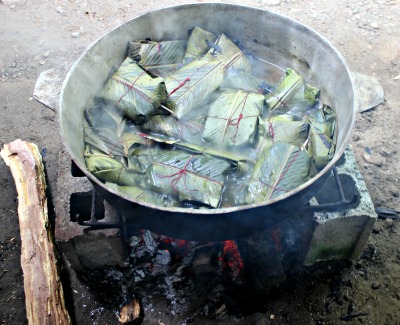
The first time I had Panamanian tamales I was under-whelmed. I had a real fondness for tamales, Mexican tamales.
Initially, I was not thrilled with the wetness of tamales in Panama. It is definitely more messy to eat than a Mexican tamale. Of course, it didn't help that whomever had made them had skimped on the chicken. It was mostly cornmeal.
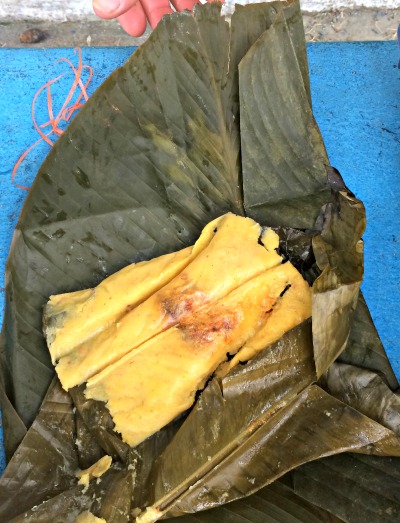
Over the years, I have grown to appreciate how much more flavor the "messy" cornmeal gives to the tamale. They cook the cornmeal in a well-spiced broth which gives it the flavor.
Now, whenever we find someone who is selling tamales we buy a few. We have learned now who puts an adequate amount of chicken in the tamales. And more importantly, who does not. I have never seen a tamale here made of anything but chicken.
I was visiting a family recently and saw these tamales cooking in their back yard (see photo). They made the tamales to feed a work crew at their house.
Making tamales takes quite a bit of work. Most people only make them during the holidays. It is a social activity, like cooking a meal for an American Thanksgiving.
To find out more, Kris of The PanamaAdventure blog, did a great post about tamales. You can find a recipes by using our friend, Google. This recipe uses only simple kitchen utensils.